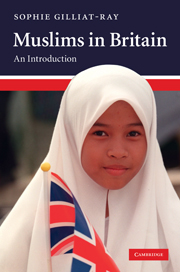Book contents
- Frontmatter
- Contents
- List of figures
- List of tables
- Preface
- Acknowledgements
- List of abbreviations
- PART I HISTORICAL AND RELIGIOUS ROOTS
- PART II CONTEMPORARY DYNAMICS
- 5 Profiling British Muslim communities
- 6 Religious nurture and education
- 7 Religious leadership
- 8 Mosques
- 9 Gender, religious identity and youth
- 10 Engagement and enterprise
- Epilogue
- Appendix: Source notes for researchers
- Glossary
- References
- Index
5 - Profiling British Muslim communities
Published online by Cambridge University Press: 05 June 2012
- Frontmatter
- Contents
- List of figures
- List of tables
- Preface
- Acknowledgements
- List of abbreviations
- PART I HISTORICAL AND RELIGIOUS ROOTS
- PART II CONTEMPORARY DYNAMICS
- 5 Profiling British Muslim communities
- 6 Religious nurture and education
- 7 Religious leadership
- 8 Mosques
- 9 Gender, religious identity and youth
- 10 Engagement and enterprise
- Epilogue
- Appendix: Source notes for researchers
- Glossary
- References
- Index
Summary
INTRODUCTION
This chapter examines Muslim communities in Britain today from a demographic and sociological perspective. British Muslims are profiled here in terms of age, gender, ethnicity, household composition, residential patterns, geographic distribution, employment, health and socio-economic status. These are of course major topics in their own right, and some of them have been systematically studied in depth. For the purposes of this book, a survey of some of the most significant patterns and trends is provided to contextualize later discussion, and reference to more in-depth research is provided accordingly.
Unless otherwise stated, much of the statistical data in this chapter is derived from the findings of the 2001 Census, and especially from a series of reports, Focus on Religion. Understanding of the demography and socio-economic structure of Muslim communities in Britain has also been substantially improved owing to quantitative analysis of 2001 Census data conducted by Serena Hussain, as part of doctoral research (Hussain, S. 2004; Hussain, S. 2008). It is worth noting, therefore, the time-bound nature of the evidence in this chapter, but the level of detail arising from the 2001 Census is such that it is likely to inform debate and policy-making until the next Census in 2011. During the intervening period there will inevitably have been significant changes in the Muslim demographic profile, particularly in terms of population growth.
Mutual self-interest on the part of British Muslims and national government has been a significant driver for gaining better information and statistical evidence in recent years.
- Type
- Chapter
- Information
- Muslims in Britain , pp. 115 - 129Publisher: Cambridge University PressPrint publication year: 2010

